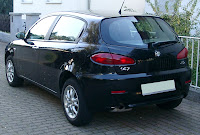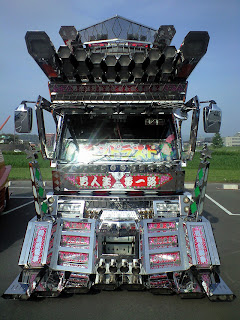Alfa Romeo 147
Manufacturer Alfa Romeo
Production 2000–2010
Assembly Pomigliano d'Arco, Italy[1]
Predecessor Alfa Romeo 145/146
Successor Alfa Romeo Giulietta
Class Small family car
Body style(s) 3 and 5-door hatchback
Layout FF layout
Engine(s) Petrol:
* 1.6 L TS I4
* 2.0 L TS I4
* 3.2 L V6
Diesel:
* 1.9 L JTD I4
Transmission(s) * 5 and 6-speed manual
* 5 and 6-speed semi-auto
* Magneti Marelli Selespeed
Wheelbase 2,546 mm (100.2 in)
Length 4,223 mm (166.3 in)
Width 1,729 mm (68.1 in)
Height 1,442 mm (56.8 in)
Curb weight 1,200–1,360 kg (2,600–3,000 lb)
Related Alfa Romeo GT
Alfa Romeo 156
Designer Walter de'Silva
The Alfa Romeo 147 is a small family car produced by Italian automaker Alfa Romeo from 2000 to 2010. The 147 was also voted European Car of the Year for 2001, beating the Ford Mondeo and the Toyota Prius.
The 147 was launched at the 2000 Turin Motor Show as a replacement for the 145 / 146 hatchbacks, and is based on the running gear of the larger 156 saloon. It was available with 1.6, 2.0, and 3.2-litre petrol engines and a 1.9-litre diesel engine.
The car was in production for ten years making it one of the oldest small family cars on sale in Europe at the time of its replacement by the Alfa Romeo Giulietta in late May 2010.
src="http://pagead2.googlesyndication.com/pagead/show_ads.js">
Styling
 |
| 2nd series Alfa Romeo 147 |
Development
 |
| 2nd series Alfa Romeo 147 |
The 147 has been replaced by the new Giulietta in 2010.
src="http://pagead2.googlesyndication.com/pagead/show_ads.js">
High-performance versions
 |
| Alfa Romeo 147 GTA |
London-based after-market tuner Autodelta has produced a "bored out" version of the GTA sporting a 3.7-litre V6, producing 328 bhp (245 kW), and a split-axle differential gear for the front wheels. Autodelta has also made a Rotrex supercharged version producing 400 bhp (300 kW).
Reviews
The handling of 147 was praised in some reviews, in spite of criticism regarding the light (sensitive) steering, which makes some drivers feel less involved. However, light steering does help during parking maneuvers. Other criticisms of the 147 included a cumbersome gearshift, unsupportive seats and the lack of interior space compared to its rivals. The car became well-known for its engine note, which is unusually mellifluous for a car of its class. The 147 suffers from fairly poor resale value in Great Britain. The 147 GTA and 147 Autodelta GTA have been road tested by Jeremy Clarkson, and featured on television show Top Gear with a power-lap around the track by The Stig. In his review of Autodelta 147 GTA car for The Sunday Times, Clarkson described the acceleration as "…Ferrari throttle? Forget it. When you stamp on the accelerator it’s like you’ve hit the Millennium Falcon’s hyperdrive. Suddenly all the stars are fluorescent tubes. …" and the handling as "....A corner was coming. And then it was a distant speck in my rear-view mirror. I vaguely remember turning the wheel and I have a dim recollection of being astounded by the grip . . . and then the moment was gone. No, really, the damn thing is a barnacle....".Awards
The Alfa Romeo 147 has won more than 27 awards including the following:- The European Car of the Year in 2001;
- Das Goldene Lenkrad ("The golden steering wheel", BILD am SONNTAG - Germany) in 2000;
- Auto Europa 1 (Panel of engineers, drivers and journalists headed by Auto Bild - Germany) in 2001;
- Trophées du design (Automobile Magazine - France) in 2000; and
- Carro Importado do Ano no Brasil - (Brazil Import car of the year) in 2002.
147 in motorsport
 |
| 147 JTD, Markus Lungstrass |























